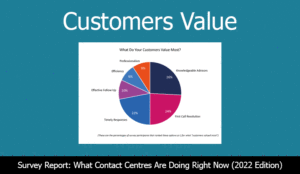Sundeep Boughan of Puzzel explores rising customer expectations and the value of putting them at the heart of customer service.
Customers are the lifeblood of every organisation, so getting the customer experience right is vital.
Every company aims to exceed service expectations, but to achieve this it’s important to understand what customers want and expect.
The reasons customers contact an organisation are varied, but one of the most common is because something has gone wrong with the customer journey.
Whether it’s a billing issue, a technical support case or an order incorrectly fulfilled, the valuable customer requires assistance.
The ease of contact and how effectively the problem is resolved will determine how satisfied they are with the service and, more importantly, how they feel about the brand.
Hanging on the Telephone
Customers do not like to be kept hanging on the telephone. In fact, according to Econsultancy research, voice volumes have dropped by 17% since 2015, with customers choosing between phone, email, webchat, SMS and social media to contact companies.
With the adoption of smartphones and tablets, customers are using more channels than ever to browse and buy, so when it comes to service, they expect the same flexible and fulfilling experience with brands whatever the communication channel.
Organisations ignoring the need for true multichannel customer experience risk falling out of step with modern consumers.
In an always-on society, people expect to use their channel of choice at a time that is convenient to them.
According to one report, when customers were asked about their desired split of interactions by channel, they averaged at: 42% telephone, 37% self-service, and 29% assisted service. This indicates that society is becoming increasingly digital-savvy.
However, it is important for an organisation to find the blend of live agents, digital assistance and self-service appropriate for its customer base.
For example, the assumption that millennials will only want a digital-centric contact offering may well be true, but that strategy is fundamentally flawed if they are not the target customer base.
Connected Customer Journeys
Emerging technologies such as Artificial Intelligence (AI) and chatbots are transforming the customer experience at a time when consumers expect 24×7 access.
However, there is little point of round-the-clock access if the channels are siloed and information isn’t shared, requiring people to explain an issue to multiple contacts.
Some organisations have been slow to acknowledge that customers aren’t satisfied with service interactions taking place via unconnected channels, buyers want effortless experiences that provide instant answers with the fastest response times.
The earlier report revealed that over half (51%) of UK consumers are comfortable crossing back and forth between numerous channels, even within a single interaction.
What’s important to the customer is receiving the same level of support through whichever medium they prefer, without the need to repeat the same information to multiple agents in different channels.
The latest cloud-based contact centre solutions deliver that seamless customer experience by incorporating standard interfaces to major CRM applications. This ensures agents have the right information at their fingertips to deliver the quality of service that customers deserve and expect.
Delivering Experiences That Matter
Although society is becoming increasingly digital-savvy, it’s important for organisations to understand that what customers ultimately want are quick answers from an engaged and knowledgeable agent.
If organisations want to deliver a great customer experience, it’s important to identify all the touchpoints between the customer and the brand, creating a 360-degree view of their interactions throughout the customer journey.
It’s only by stepping back from long-held assumptions and observing consumer behaviours within and across channels that organisations can generate new insights.
Companies that take the time to understand who their customers are and the types of interactions they want will differentiate themselves from the pack and reap the economic benefit of meeting their customers’ needs.

Sundeep Boughan
It is important to understand what customers want compared to the customer experience you are trying to deliver.
Once you have established both of these are in sync, choosing the right method of delivery to meet expectations becomes much easier.
As Steve Jobs of Apple fame once said: “You have to start with the customer experience and work backwards to the technology.”
Author: Robyn Coppell
Published On: 24th Jul 2018 - Last modified: 31st Jul 2018
Read more about - Guest Blogs, Puzzel















